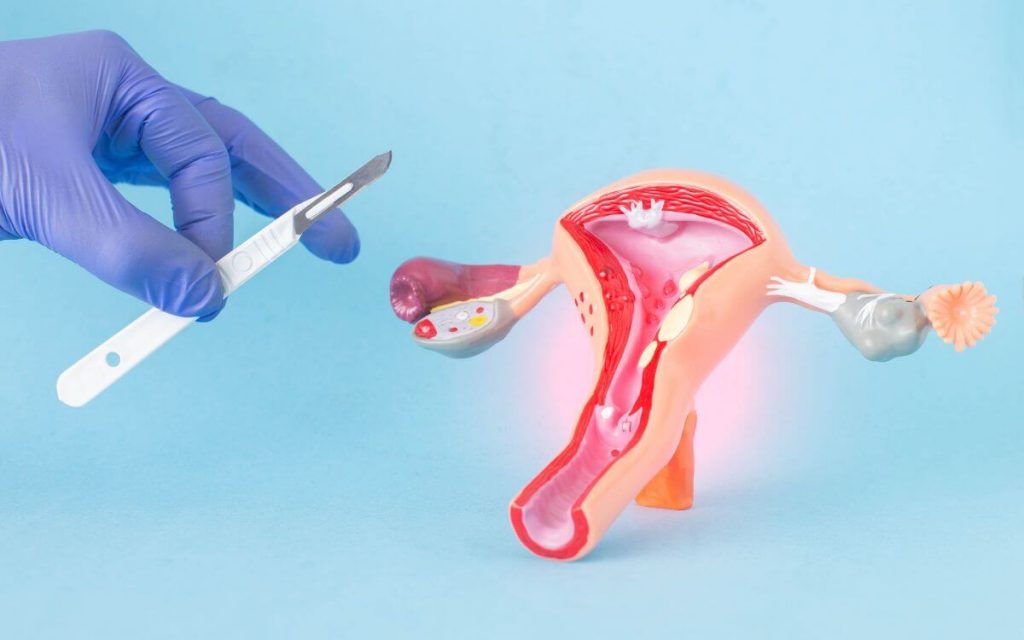Which female illness cannot be cured without surgery?
There are a number of chronic conditions that cannot be cured. My wife suffers from two of them. One is fibromyalgia, but this disorder doesn’t require surgical procedures. The second condition is endometriosis, but because this female illness cannot be cured without surgery, I’d like to focus on endometriosis today.
Other conditions that may require surgery include ovarian cysts, uterine fibroids, and pelvic inflammatory disease. In some cases, these conditions can be cured with medication or other non-surgical treatments, but in other cases, surgery is the only option.
Today, I want to discuss endometriosis, and how it can often be a chronic illness that requires repetitive surgery.
Let’s begin with the basics…
What is endometriosis?
Endometriosis is an insidious chronic illness in which tissue similar to the one that lines the uterus grows outside of the uterus. This can cause really excruciating pain and even infertility. This is a female illness that requires ongoing surgery.
The cause of endometriosis is unknown, though there are a number of theories such as:
- retrograde menstruation
- hormone imbalances
- immune system dysfunction
- genetic predisposition
- environmental toxins
- sometimes pelvic surgery
Pelvic surgery such as a C-section can also cause endometriosis by leaving behind scar tissue that becomes endometriotic. This is why it’s important to talk to your doctor about your options before having any type of surgery.
Endometriosis expands beyond the uterus and can attach to the fallopian tubes, ovaries, bowels, and bladder. This can cause a lot of pain during menstruation as well as pain during sex, urination, and bowel movements.
There is no cure for endometriosis, but there are treatments that can help to manage the symptoms. These include:
- hormonal therapy
- non-steroidal anti-inflammatory drugs (NSAIDs)
- pain medication
- surgery
If you want to learn more about endometriosis, I wrote an “Endo-Tool, Endometriosis for Men” e-Book.
You can get the 1st Chapter of the e-Book for FREE, and if you like it, you’ll get a Whopping 33% Discount on the Whole Book, plus discounts on other helpful tools. You have nothing to lose but a lot to gain!
The first chapter alone contains all the comprehensive medical knowledge about endometriosis, including:
- What is endometriosis?
- What are the symptoms?
- What causes endometriosis?
- What does endometriosis look like?
- What are the stages?
- What are the types?
- What is adenomyosis and how is it related to endometriosis?
- Why do some women develop severe endo and others don’t?
- Does endometriosis cause infertility?
- How is endometriosis diagnosed?
- Do types and stages affect the treatment?
- Recurrence of endometriosis after excision surgery.
FREE Chapter of “Endo-Tool”
Endometriosis e-Book for Men

Types of endometriosis.
Endometriosis is a female illness that cannot be cured without surgery. Some claim that stage I can be cut out completely, but in my opinion, as of today, it cannot be cured at all. There are four main types of endometriosis: superficial, endometriomas, deep infiltrating endometriosis, and abdominal wall endometriosis.
- Superficial – the peritoneum is a thin membrane that lines your abdomen and pelvis.
- Endometriomas – cysts filled with dark fluid, mostly blood.
- Deeply infiltrating endometriosis – penetrating deeper than 5mm below the peritoneal surface.
- Abdominal wall endometriosis – intramuscular.
Stages of endometriosis.
Even though specialists in the UK aren’t keen on staging, there are four stages of endometriosis: minimal, mild, moderate, and severe.
- Stage 1 – minimal. There’s little to no scar tissue.
- Stage 2 – mild. There are more implants than in stage one. They’re also deeper in the tissue.
- Stage 3 – moderate. There are many deep implants. There also may be small cysts on one or both ovaries, and scar tissue called adhesions.
- Stage 4 – severe. This is widespread. There are many deep implants and thick adhesions. There are also large cysts on one or both ovaries.
Why this female illness cannot be cured without surgery?
Because there is no cure for endometriosis. Pronto.
While endometriosis cannot be cured, surgery helps to remove the tissue that has grown outside of the uterus. Endometriosis can be managed with a holistic approach, medications, and other treatments, but eventually, most women will need surgery.
Why?
Endometriosis surgery is the only way to definitively diagnose and treat the condition. People try to diagnose it with MRIs and ultrasounds, but the only way to know for sure is through surgery.
Surgery is also the only way to confirm and remove endometriosis tissue. This can help to relieve pain and improve fertility. Because this female illness cannot be cured without surgery, eventually, endometriosis requires ongoing surgery.
My wife had originally planned a diagnostic laparoscopy that was supposed to last an hour or so, however, she stayed under the knife for 4,5 hours and was diagnosed with the worst type – stage IV deep infiltrating endometriosis.

What are the types of endometriosis surgeries?
Laparoscopy – it’s a type of minimally invasive surgery. It requires the use of a small, slender camera called a laparoscope, causing usually three small incisions to see into her abdomen.
It’s performed under general anesthesia. This means that she’ll be asleep while the procedure is being performed and she won’t feel anything.
Laparoscopic surgery involves making small incisions in the abdomen and inserting a camera to look for endometriosis lesions. If the lesion is small, it can be removed with laparoscopic surgery, however, if the lesion is large, a laparotomy may be necessary.
Laparotomy – it’s also called “open surgery” but is considered major abdominal surgery, using a slightly larger incision than laparoscopy. In the same way, laparotomy is performed under general anesthesia, again, she will be sleeping and won’t feel pain during her surgery.
Laparotomy is often used to remove large endometriosis lesions, as well as the ovaries and fallopian tubes. Laparotomy for endometriosis is rare but may be used when her endometriosis is extensive or can’t be seen well-using laparoscopy.
Hysterectomy – it’s a procedure used to treat severe endometriosis when preserving fertility isn’t an issue. Hysterectomy removes the uterus, cervix, and ovaries.
A hysterectomy is often combined with a salpingo-oophorectomy, which is the removal of the fallopian tubes and ovaries. This type of surgery is usually only recommended when all other treatment options have failed.
What can you expect after endometriosis surgery?
After any type of surgery, it’s normal to feel some pain and discomfort. She may also have swelling and bruising around the incision site.
Most women report improved pain relief after endometriosis surgery. However, the tissue can grow back, and the pain may return. It’s important to talk to her doctor about what to expect after surgery and follow their instructions for a healthy recovery.
Surgery is often the best way to manage endometriosis, but it’s not a cure. Endometriosis is a female illness that needs repetitive surgery because the tissue can grow back, and the pain may return. However, for many women, surgery is the best way to improve their quality of life.
For some women, endometriosis will eventually lead to infertility. If you want to have children, it’s important to talk to your doctor about your fertility options before having surgery.
Many women with endometriosis require multiple surgeries over the course of their lives. This female illness cannot be cured without surgery.
Conclusion on female illness that needs repetitive surgery.
Which female illness cannot be cured without surgery?
It could be PCOS, or it could be uterine fibroids. However, there are many more female illnesses that need repetitive surgery in order to manage the symptoms. These female illnesses cannot be cured without surgery, but endometriosis is one of the most common.
One in every ten women has endometriosis. But endometriosis or not, if you are suffering from any type of female illness that requires ongoing surgery, be sure to talk to your doctor about your options.
Taking all into the account, it’s important to consider all options and speak with your doctor about what is best for you and your particular case because every woman has unique circumstances, environment, age, type, and stage.
You are unique, like everyone else. So before your procedure, it’s important for you to know that:
- this female illness cannot be cured without surgery or even with it
- this debilitating female illness cannot be cured without surgery
- endometriosis is a female illness that requires ongoing surgery
this female illness that cannot be cured without surgery can, however, be managed with the help of a number of different treatments like a holistic approach, medications, and other treatments. Eventually, most women with endometriosis will need surgery.
I hope this helps!
FREE Chapter of “Endo-Tool”
Endometriosis e-Book for Men



About Me
Hi, I’m Lucjan! The reason why I decided to create this blog was my beautiful wife, who experienced a lot of pain in life, but also the lack of information about endometriosis and fibromyalgia for men…
